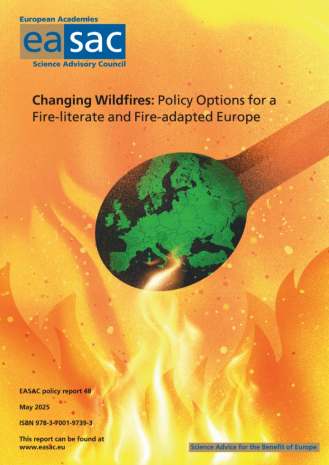Across the globe, wildfires are increasing in intensity and scale. This report focuses on wildfires in Europe, which are also changing in frequency, timing and intensity. For example, by the end of this century, Southern Europe will face more high-intensity wildfires than today; and on the regional scale, such events may occur as frequently as once every two years. Europe will increasingly have to learn to live with fire and adapt society to a new challenging reality. This report by the European Academies Science Advisory Council (EASAC) critically analyses, on the basis of the most recent scientific evidence of the effectiveness of suitable proactive approaches, the state of knowledge intended to reduce increasing wildfire impacts, framed in local and regional contexts.
The climate is changing, and in many parts of Europe there will be a large increase in multi-year droughts, leading to an increased probability of extreme fires. In addition to climate change, much of the increase in large wildfires is attributed to widespread land-use change in Europe, with the conversion of open landscapes to those of shrub and forest. Current fire-management policies focus mostly on suppression and are clearly inadequate for addressing the impacts of severe fire seasons associated with changes in the climate and land-use.
Europe is a diverse continent where the conditions and drivers of change differ substantially across regions, with the Mediterranean region having the highest probability of very severe wildfires in the future. However, continental, alpine and boreal regions also need to be prepared for increased fire risk. The combined effects of socio-economic, ecological and climatic trends have led to a shift in regional fire regimes from being fuel-limited to weather-driven. Compared with historical patterns, the area burned today has fewer, larger fires, including extreme high-intensity wildfire events, which poses significant environmental and risk management challenges.
This report also highlights the fact that wildfires have more than just negative impacts. Many ecosystems are adapted to fire, and the use of fire by humans has a very long history, especially in Europe. The impacts of fires on ecosystems depend on when, where, how and how often they burn, with some ecosystems even being dependent on fire. The positive impacts of wildfires in the environment never reach the news, whereas wildfire loss and damage do. EASAC also emphasises the utmost need for strengthening institutional capabilities to address effective wildfire risk governance, cooperation and coordination among stakeholders, as well as efforts to increase fire literacy. In addition to increasing budget expenditures for prevention and restoration, and adopting a system to allow effective sharing of sufficient suppression resources among the European Union’s (EU’s) member states, this report calls for European policies to recognise fire as an intrinsic process in European landscapes and to reinforce investments in land-use planning, agriculture and environment policies.
The report links to several of the EU’s policy areas, such as the Common Agricultural Policy, Climate Strategy, Biodiversity Strategy, Farm to Fork Strategy, the Forest Strategy, and the new Nature Restoration Law, and proposes policy options that are becoming increasingly urgent to be implemented at both the EU and member state levels. The report also explores design principles for the planned large-scale EU tree-planting programme to avoid inappropriately adding substantial amounts of flammable fuel in landscapes that are already vulnerable across Europe.
The report concludes by launching a toolbox of three urgent key messages and eight policy options to enable better management of fires today and to prepare and adapt society for fires in the future. EASAC’s work relies on the input and contributions of Europe’s leading scientific experts.
Read and download the infographic summarising the core findings and proposals from the report, here.

